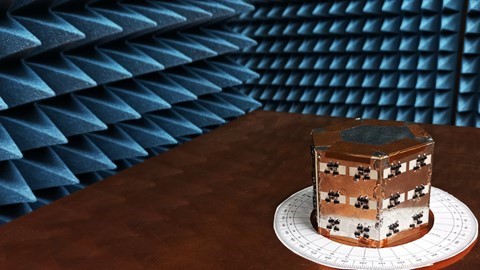RESEARCH NEWS - Towards a New Antenna Paradigm with Waveform-Selective Metasurfaces
Category:News|Publishing : February 28, 2023
When you tap on your phone screen to check something on the internet, you make use of wireless communications technology. With the advent of 5G networks, this technology has made our lives easier than we could imagine. As we progress towards 6G communication, the use of Internet of Things (IoT) devices to monitor and perform tasks is becoming inevitable. As a result, there is a growing demand for the services provided by such devices.
However, the frequency resources accessible to the IoT devices remain limited. Consequently, there has been a lot of research focused on using various modulation schemes to fit in more data without causing interference. Yet, however, they have ignored one important aspect of wireless communication: conventional antennas respond to signals at the same frequency in the same manner. However, if one were to modulate the antenna performance for a fixed frequency based on other aspects of the signal waveform, like its pulse width, it would add a whole new degree of freedom that can be exploited to transfer data efficiently.
Fortunately, this is exactly what a team of researchers led by Dr Hiroki Wakatsuchi from Nagoya Institute of Technology (NITech), Japan have accomplished. In their paper published in Nature Communications on February 06, 2023, the researchers put forth a new system that uses "metasurfaces" to create waveform-based selectivity in antennas. "Classic antennas are incapable of varying their performance, for example, its radiation pattern, at a fixed frequency. In our study, we introduced a new degree of freedom to change antenna performance and control electromagnetic waves/signals even at the same frequency by using 'metasurfaces,' artificially engineered electromagnetic structures that can produce electromagnetic properties based on the signal received. In particular, our metasurfaces show unique behavior that selectively transmits incoming signals in response to their pulse width, which is applied to the antenna design," explains Dr. Wakatsuchi. The study involved contributions from Dr. Ashif Amunulloh Fathnan from NITech, Dr. Christos Christopoulos from The University of Nottingham, UK, and Dr. Filiberto Bilotti of the ROMA TRE University, Italy.
Put simply, metasurfaces are artificially generated surfaces that can augment electromagnetic waves based on their properties. Accordingly, the researchers used non-linear metasurfaces to change the response properties of the antenna for waves of the same frequency but with different waveforms.
By performing both experiments and numerical simulations, the researchers demonstrated that their antenna design was fully capable of selectively receiving/transmitting both surface and free-space waves. They also proposed several applications for their design, including the steering of a main beam, receiving signals under simultaneous incidence, and building a mutual communication system without needing a frequency change or an external power supply.
"With our technology advancing towards 6G and 7G networks, cyber spaces and physical spaces are becoming more closely associated. Using multiple IoT devices, we would be able to create a digital twin for each physical space. Such a concept of cyber-physical space will require a substantial number of IoT sensors to be deployed in physical spaces to collect information without severe electromagnetic interference occurring between these devices to ensure real-time time update," comments Dr. Wakatsuchi. "Our study contributes to this future by providing a way to harmonize wireless communications while increasing the number of communication devices at the same frequency."
And we sure are looking forward to this future!

Metasurface-based waveform-selective reconfigurable antenna.
An international research team has developed reconfigurable antennas using artificially engineered structures called "metasurfaces" that can help solve the issue of limited frequency resources for wireless communications. These antennas provide variable response to waves of the same frequency but different pulse width. Thus, it provides a new degree of freedom to these antennas, making for more efficient data transfer.
Image credit: Hiroki Wakatsuchi from NITech, Japan
Reference
|
Title of original paper |
Pulse-driven self-reconfigurable meta-antennas |
|
Journal |
Nature Communications |
|
DOI |
|
|
Latest Article Publication Date |
February 6, 2023 |
About Associate Professor Hiroki Wakatsuchi from Nagoya Institute of Technology, Japan
Dr. Hiroki Wakatsuchi is an Associate Professor in the Department of Engineering at Nagoya Institute of Technology (NITech), Japan. He completed his PhD from The University of Nottingham, UK whereupon he did his postdoctoral research at UC San Diego, USA. His research interests include electromagnetics, electronics, and communications. He has so far published 62 papers with over 800 citations to his credit. Dr. Wakatsuchi is also a part of the Precursory Research for Embryonic Science and Technology (PRESTO) in the Japan Science and Technology Agency (JST).
Funding information
This work was supported in part by the Japanese Ministry of Internal Affairs and Communications (MIC) under the Strategic Information and Communications R&D Promotion Program (SCOPE) No. 192106007, the Japan Science and Technology Agency (JST) under the Precursory Research for Embryonic Science and Technology (PRESTO) No. JPMJPR193A, and Japan Society for the Promotion of Science (JSPS) KAKENHI No. 17KK0114 and No. 21H01324, and the research contract MANTLES funded by the Italian Ministry of University and Research, PRIN 2017 No. 2017BHFZKH.
Contact
Associate Professor Hiroki Wakatsuchi
TEL : +81-52-735-5504
E-mail : wakatsuchi.hiroki[at]nitech.ac.jp
Links : Wakatsuchi Lab.
*Please replace [at] with @ when contacting.
Ena City's Mayor, Matsusaka City's Mayor, and Minokamo City's Mayor Visit NITech FEATURE STORY - Frescoes, in a Flash: Nagoya Institute of Technology Researchers Create Frescoes in a Single Day

 Japanese
Japanese